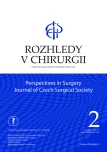Ultrasound diagnostics of a rare injury of the unossified pediatric skeleton – case report
Authors:
M. Čepelík 1; H. Melínová 2; P. Havránek 1; T. Pešl 1
Authors‘ workplace:
Klinika dětské chirurgie a traumatologie 3. lékařské fakulty Univerzity Karlovy a Fakultní Thomayerovy nemocnice, Praha
1; Radiodiagnostické oddělení, Fakultní Thomayerova nemocnice, Praha
2
Published in:
Rozhl. Chir., 2022, roč. 101, č. 2, s. 85-89.
Category:
Case Report
doi:
https://doi.org/10.33699/PIS.2022.101.2.85–89
Overview
Plain X-ray remains a standard diagnostic tool for evaluation of skeletal injuries in children. However, it provides inadequate imaging of unossified, cartilaginous parts of pediatric bones. Our article presents the possibilities of ultrasound imaging based on the case report of a seven years old patient with a rare injury of the unossified medial epicondyle of the humerus where the diagnosis and indication for osteosynthesis has been made based on ultrasound examination of the injured elbow. Ultrasound imaging is an ideal, accessible and affordable examination not stressful for the patient; this technique can be used to verify of skeletal injuries that cannot be diagnosed by plain X-ray. Ultrasound imaging should be a standard part of the diagnostic algorithm of skeletal injuries in the pediatric population where a discrepancy is present between distinctive symptoms and negative radiographs.
Keywords:
ultrasound – fracture – child – ultrasonography – case report
Sources
1. Havránek P, et al. Dětské zlomeniny, 2. vyd. Praha, Galén, 2013 : 389. ISBN 978-80 - 7262-983-1.
2. Čepelík M, Pešl T, Havránek P. Vývojová morfologie loketního kloubu ve vztahu k poranění dětského skeletu. Úraz Chir. 2018;26(1):3−7.
3. Biswas D, Bible JE, Bohan M, et al. Radiation exposure from musculoskeletal computerized tomographic scans. J Bone Joint Surg Am. 2009 Aug;91(8):1882−1889. doi:10.2106/JBJS.H.01199.
4. Kim HH, Gauguet JM. Pediatric elbow injuries. Semin Ultrasound CT MR. 2018 Aug;39(4):384−396. doi:10.1053/j. sult.2018.03.005. Epub 2018 Mar 23. PMID: 30070231.
5. Kane D, Grassi W, Sturrock R, et al. A brief history of musculoskeletal ultrasound: ‚From bats and ships to babies and hips‘. Rheumatology (Oxford) 2004 Jul;43(7):931−933. doi:10.1093/rheumatology/ keh004.
6. Saul T, Ng L, Lewiss RE. Point-of-care ultrasound in the diagnosis of upper extremity fracture-dislocation. A pictorial essay. Med Ultrason. 2013 Sep;15(3):230−236. doi:10.11152/mu.2013.2066.153.ts1ln2.
7. Ackermann O, Simanowski J, Eckert K. Fracture ultrasound of the extremities. Ultraschall Med. 2020 Feb;41(1):12−28. doi:10.1055/a-1023-1782.
8. Rabiner JE, Khine H, Avner JR, et al. Accuracy of point-of-care ultrasonography for diagnosis of elbow fractures in children. Ann Emerg Med. 2013 Jan;61(1):9−17. doi:10.1016/j. annemergmed.2012.07.112. Epub 2012 Nov 9.
9. Bartl V, Melichar I, Skotáková J, et al. Ultraschalldiagnostik der distalen Humerusfraktur bei Säuglingen und Kleikindern. Kindertraumatologie. Frakturen des distalen Humerus, Segment 13. 1ed. Wiesbaden: Universum Verlagsanstalt 1998 : 66−68. ISBN 3-923221-61-4.
10. May DA, Disler DG, Jones EA, et al. Using sonography to diagnose an unossified medial epicondyle avulsion in a child. AJR Am J Roentgenol. 2000 Apr;174(4):1115−1117. doi:10.2214/ ajr.174.4.1741115.
11. Gottschalk HP, Eisner E, Hosalkar HS. Medial epicondyle fractures in the pediatric population. J Am Acad Orthop Surg. 2012 Apr;20(4):223−232. doi:10.5435/ JAAOS-20-04-223.
12. Tanabe K, Miyamoto N. Fracture of an unossified humeral medial epicondyle: use of magnetic resonance imaging for diagnosis. Skeletal Radiol. 2016 Oct;45(10):1409−1412. doi:10.1007/ s00256-016-2434-3. Epub 2016 Aug 1.
Labels
Surgery Orthopaedics Trauma surgeryArticle was published in
Perspectives in Surgery

2022 Issue 2
Most read in this issue
- Conservative versus surgical treatment of displaced midshaft clavicle fracture in adolescents
- Retrospective analysis of necrotizing pneumonia in children between 2015–2019
- Initial experience with single incision laparoscopic appendectomy
- Robotic pyeloplasty in children – a pilot study
